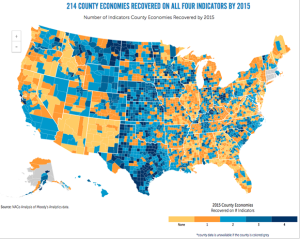Those of you who watched the State of the Union address last night know that President Obama spent some time, as usual, crowing about his economic record. To my surprise, he mentioned the “Great Recession” only once, but he spent plenty of time talking about how the economy has grown during his term is office. As you might expect, these words need to be taken with a grain of salt. A recent study from the National Association of Counties (NACO) provides more evidence to support our suspicions. According to their study, across all of the United States’ 3069 counties that have their own county government, only 214, or 7%, of them have recovered to pre-Recession levels on all four of their indicators, jobs, unemployment rate, GDP recovery, and home prices. That means 2882 of the counties NACO considered have yet to do so. From their report:
By 2015, 214 county economies recovered to their pre-recession levels on all four indicators analyzed, almost three times more than by 2014. Most of these county economies are in Texas, Nebraska and Kansas. For the first time, 17 of the 126 large county economies — in counties with more than 500,000 residents — are part of this group. The majority are in California and Texas.
Overall, the county economies recovered on all four indicators by 2015 still represent only 7 percent of all county economies. In contrast, almost 16 percent of county economies had not recovered on any indicator by 2015, mostly in the South and Midwest. States such as Florida, Georgia, Illinois and Mississippi have more than a third of their county economies still reeling from the latest downturn across all economic indicators.
The report has this section under the cheery sounding subheading “Economic Recovery is Spreading Out”, but it’s really hard to see this in too positive a light. For those interested, here is the relevant map:
As you can see, the darkest blue indicates counties that have totally recovered on all four of their indicators. Most of the country’s counties, though, are still stuck on the lower end of the spectrum. As you can see, the colors for 0-2 recovered indicators far out number the fully and mostly recovered counties.
It does qualify as progress, I suppose, from last year when, as the Wall Street Journal noted, the organization’s study found only 65 of the nation’s counties had recovered on all four points. The Journal has done the hard work of crunching the numbers on NACO’s study. Here is what they have note:
Last year, 72 of the recovered counties were in Texas, the most of any state. Nebraska followed with 22. Minnesota, Kentucky, North Dakota, Montana and Kansas each had at least 10 fully recovered counties.
Meanwhile, in 27 states, not a single county had fully recovered.
Some of the nation’s largest counties finally recovered from the recession in 2015, including the counties containing
Denver, San Francisco, San Jose, Dallas and Columbus, Ohio. In 2014, no county with more than 500,000 residents had fully recovered. Last year, 17 of 126 had.
That’s progress from nothing, but it’s still pathetic that only just over 13% of our nation’s largest counties with county governments have fully recovered from the Great Recession. These are our nation’s population centers, and this study makes it plain that they are still suffering. The counties containing cities like Detroit, Miami, Cleveland, Jacksonville, Tucson, and Las Vegas, along with many other populous counties like Orange County, California, are still stuck on the orange end of the spectrum. This also applies to many other major cities that fall short of 500,000, like St. Louis and New Orleans. Other large cities, notably Chicago, Los Angeles, and San Diego, are in counties that have only halfway recovered from the recession, by the NACO’s four indicators.
It’s interesting to note here that most of the fully recovered counties are, as the Journal notes, in energy-rich areas of the country. Even with the recent downturn in oil prices, counties in the oil-rich states of North Dakota*, Texas, and Nebraska, among others, continue to dominate the map, but it’s also important to note that many of these counties in the Great Plains States are not very large in population either, so the large mass of blues in the center of the country is somewhat deceiving in that respect.
That so few counties have recovered from the recession is something that Barack Obama absolutely should have mentioned in his State of the Union addressed. Instead, he provided an overview of what he considers his “accomplishments”, and he neglected to seriously talk about our country’s still prevalent economic problems as well. It might be unrealistic to expect all of the nation’s counties to be fully recovered by this point, but under any President with a competent economic policy, we would be looking at much better numbers. We can also be sure that this map will not get much better if our country continues to elect Democrats to the Presidency, so if you need even more reasons to get out and vote Republican this November, the NACO has just given you 2882 of them.
SOURCE: Jake, RedState.com
